Food Safety Management Report: Analysis for Flat Three Restaurant
VerifiedAdded on 2020/06/04
|11
|2915
|26
Report
AI Summary
This report provides a comprehensive analysis of food safety management, focusing on the practices of the Flat Three restaurant. It begins with an introduction to food safety and its importance in reducing food-borne diseases, followed by a discussion on physical and chemical contamination controls, a comparison of food poisoning and food-borne infections, and methods for controlling food-borne illnesses. The report categorizes food spoilage agents and explores various food preservation methods, evaluating their effectiveness. It then delves into key steps in temperature control systems, safe food storage methods, the importance of personal hygiene, cleaning and disinfection processes, pest control problems, hygiene design and construction, and the significance of training as a quality assurance mechanism. Finally, the report examines food hazard risk assessment, food safety control systems, and food safety guidelines for legislative compliance, concluding with a summary of the findings and recommendations for maintaining food safety standards within the restaurant setting.
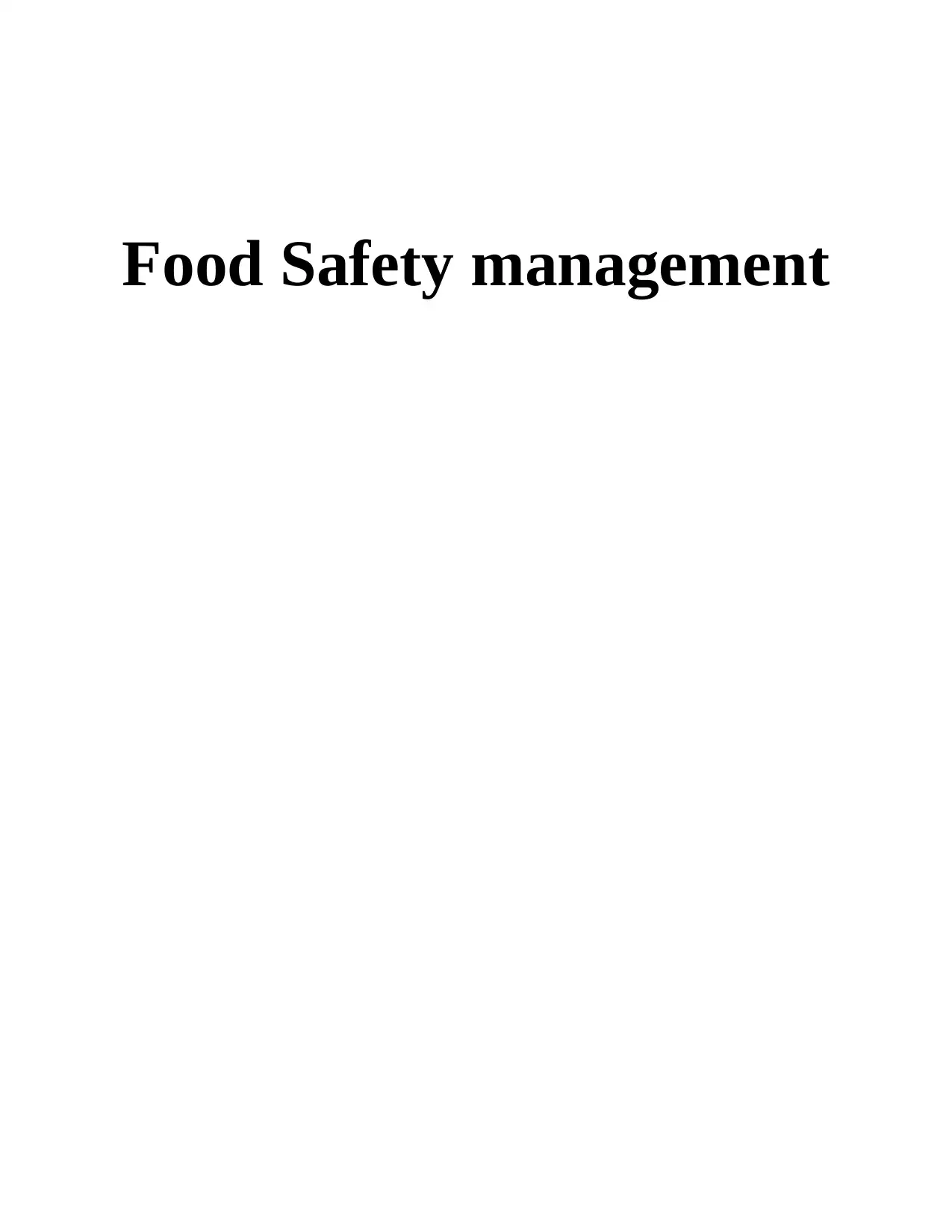
Food Safety management
Paraphrase This Document
Need a fresh take? Get an instant paraphrase of this document with our AI Paraphraser
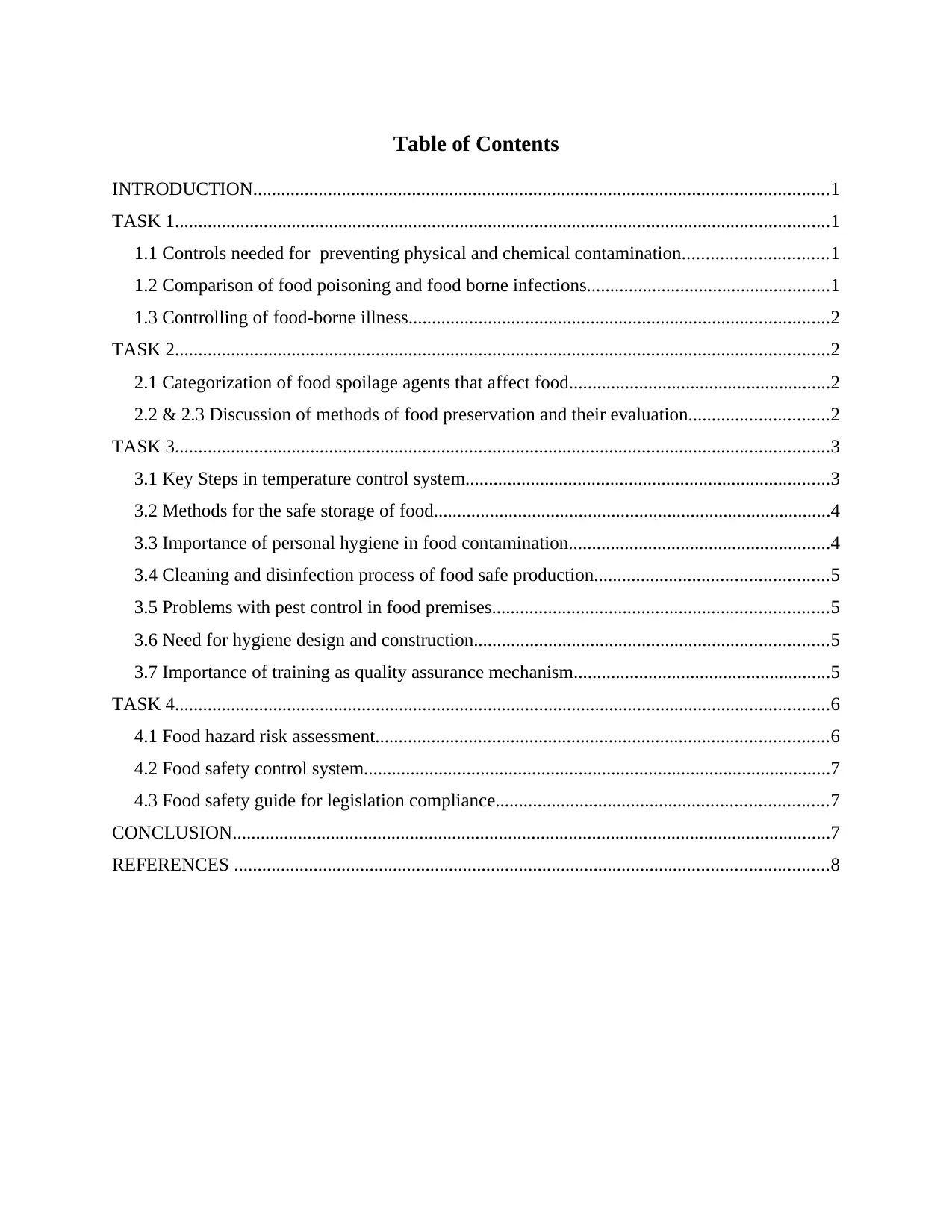
Table of Contents
INTRODUCTION...........................................................................................................................1
TASK 1............................................................................................................................................1
1.1 Controls needed for preventing physical and chemical contamination...............................1
1.2 Comparison of food poisoning and food borne infections....................................................1
1.3 Controlling of food-borne illness..........................................................................................2
TASK 2............................................................................................................................................2
2.1 Categorization of food spoilage agents that affect food........................................................2
2.2 & 2.3 Discussion of methods of food preservation and their evaluation..............................2
TASK 3............................................................................................................................................3
3.1 Key Steps in temperature control system..............................................................................3
3.2 Methods for the safe storage of food.....................................................................................4
3.3 Importance of personal hygiene in food contamination........................................................4
3.4 Cleaning and disinfection process of food safe production..................................................5
3.5 Problems with pest control in food premises........................................................................5
3.6 Need for hygiene design and construction............................................................................5
3.7 Importance of training as quality assurance mechanism.......................................................5
TASK 4............................................................................................................................................6
4.1 Food hazard risk assessment.................................................................................................6
4.2 Food safety control system....................................................................................................7
4.3 Food safety guide for legislation compliance.......................................................................7
CONCLUSION................................................................................................................................7
REFERENCES ...............................................................................................................................8
INTRODUCTION...........................................................................................................................1
TASK 1............................................................................................................................................1
1.1 Controls needed for preventing physical and chemical contamination...............................1
1.2 Comparison of food poisoning and food borne infections....................................................1
1.3 Controlling of food-borne illness..........................................................................................2
TASK 2............................................................................................................................................2
2.1 Categorization of food spoilage agents that affect food........................................................2
2.2 & 2.3 Discussion of methods of food preservation and their evaluation..............................2
TASK 3............................................................................................................................................3
3.1 Key Steps in temperature control system..............................................................................3
3.2 Methods for the safe storage of food.....................................................................................4
3.3 Importance of personal hygiene in food contamination........................................................4
3.4 Cleaning and disinfection process of food safe production..................................................5
3.5 Problems with pest control in food premises........................................................................5
3.6 Need for hygiene design and construction............................................................................5
3.7 Importance of training as quality assurance mechanism.......................................................5
TASK 4............................................................................................................................................6
4.1 Food hazard risk assessment.................................................................................................6
4.2 Food safety control system....................................................................................................7
4.3 Food safety guide for legislation compliance.......................................................................7
CONCLUSION................................................................................................................................7
REFERENCES ...............................................................................................................................8

⊘ This is a preview!⊘
Do you want full access?
Subscribe today to unlock all pages.

Trusted by 1+ million students worldwide
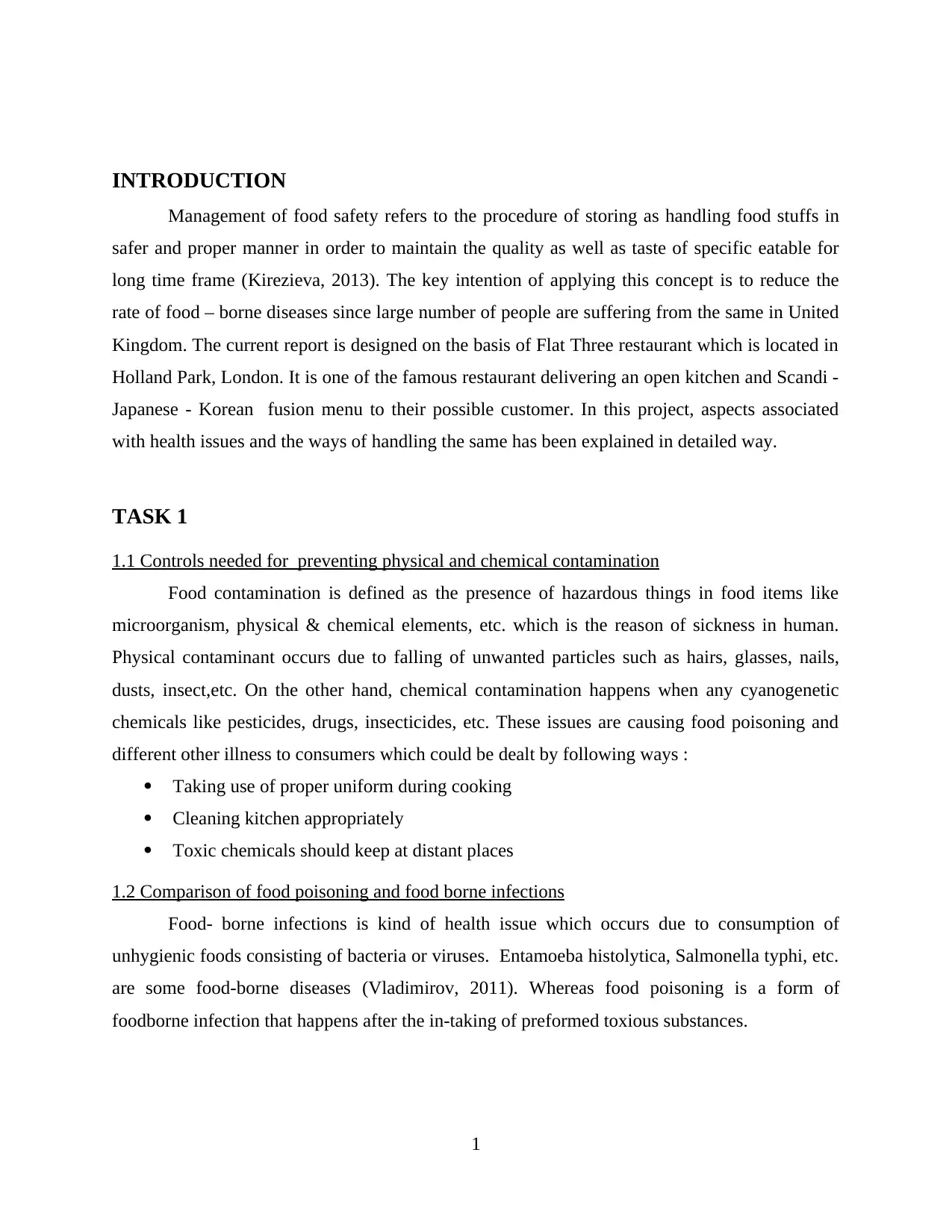
INTRODUCTION
Management of food safety refers to the procedure of storing as handling food stuffs in
safer and proper manner in order to maintain the quality as well as taste of specific eatable for
long time frame (Kirezieva, 2013). The key intention of applying this concept is to reduce the
rate of food – borne diseases since large number of people are suffering from the same in United
Kingdom. The current report is designed on the basis of Flat Three restaurant which is located in
Holland Park, London. It is one of the famous restaurant delivering an open kitchen and Scandi -
Japanese - Korean fusion menu to their possible customer. In this project, aspects associated
with health issues and the ways of handling the same has been explained in detailed way.
TASK 1
1.1 Controls needed for preventing physical and chemical contamination
Food contamination is defined as the presence of hazardous things in food items like
microorganism, physical & chemical elements, etc. which is the reason of sickness in human.
Physical contaminant occurs due to falling of unwanted particles such as hairs, glasses, nails,
dusts, insect,etc. On the other hand, chemical contamination happens when any cyanogenetic
chemicals like pesticides, drugs, insecticides, etc. These issues are causing food poisoning and
different other illness to consumers which could be dealt by following ways :
Taking use of proper uniform during cooking
Cleaning kitchen appropriately
Toxic chemicals should keep at distant places
1.2 Comparison of food poisoning and food borne infections
Food- borne infections is kind of health issue which occurs due to consumption of
unhygienic foods consisting of bacteria or viruses. Entamoeba histolytica, Salmonella typhi, etc.
are some food-borne diseases (Vladimirov, 2011). Whereas food poisoning is a form of
foodborne infection that happens after the in-taking of preformed toxious substances.
1
Management of food safety refers to the procedure of storing as handling food stuffs in
safer and proper manner in order to maintain the quality as well as taste of specific eatable for
long time frame (Kirezieva, 2013). The key intention of applying this concept is to reduce the
rate of food – borne diseases since large number of people are suffering from the same in United
Kingdom. The current report is designed on the basis of Flat Three restaurant which is located in
Holland Park, London. It is one of the famous restaurant delivering an open kitchen and Scandi -
Japanese - Korean fusion menu to their possible customer. In this project, aspects associated
with health issues and the ways of handling the same has been explained in detailed way.
TASK 1
1.1 Controls needed for preventing physical and chemical contamination
Food contamination is defined as the presence of hazardous things in food items like
microorganism, physical & chemical elements, etc. which is the reason of sickness in human.
Physical contaminant occurs due to falling of unwanted particles such as hairs, glasses, nails,
dusts, insect,etc. On the other hand, chemical contamination happens when any cyanogenetic
chemicals like pesticides, drugs, insecticides, etc. These issues are causing food poisoning and
different other illness to consumers which could be dealt by following ways :
Taking use of proper uniform during cooking
Cleaning kitchen appropriately
Toxic chemicals should keep at distant places
1.2 Comparison of food poisoning and food borne infections
Food- borne infections is kind of health issue which occurs due to consumption of
unhygienic foods consisting of bacteria or viruses. Entamoeba histolytica, Salmonella typhi, etc.
are some food-borne diseases (Vladimirov, 2011). Whereas food poisoning is a form of
foodborne infection that happens after the in-taking of preformed toxious substances.
1
Paraphrase This Document
Need a fresh take? Get an instant paraphrase of this document with our AI Paraphraser
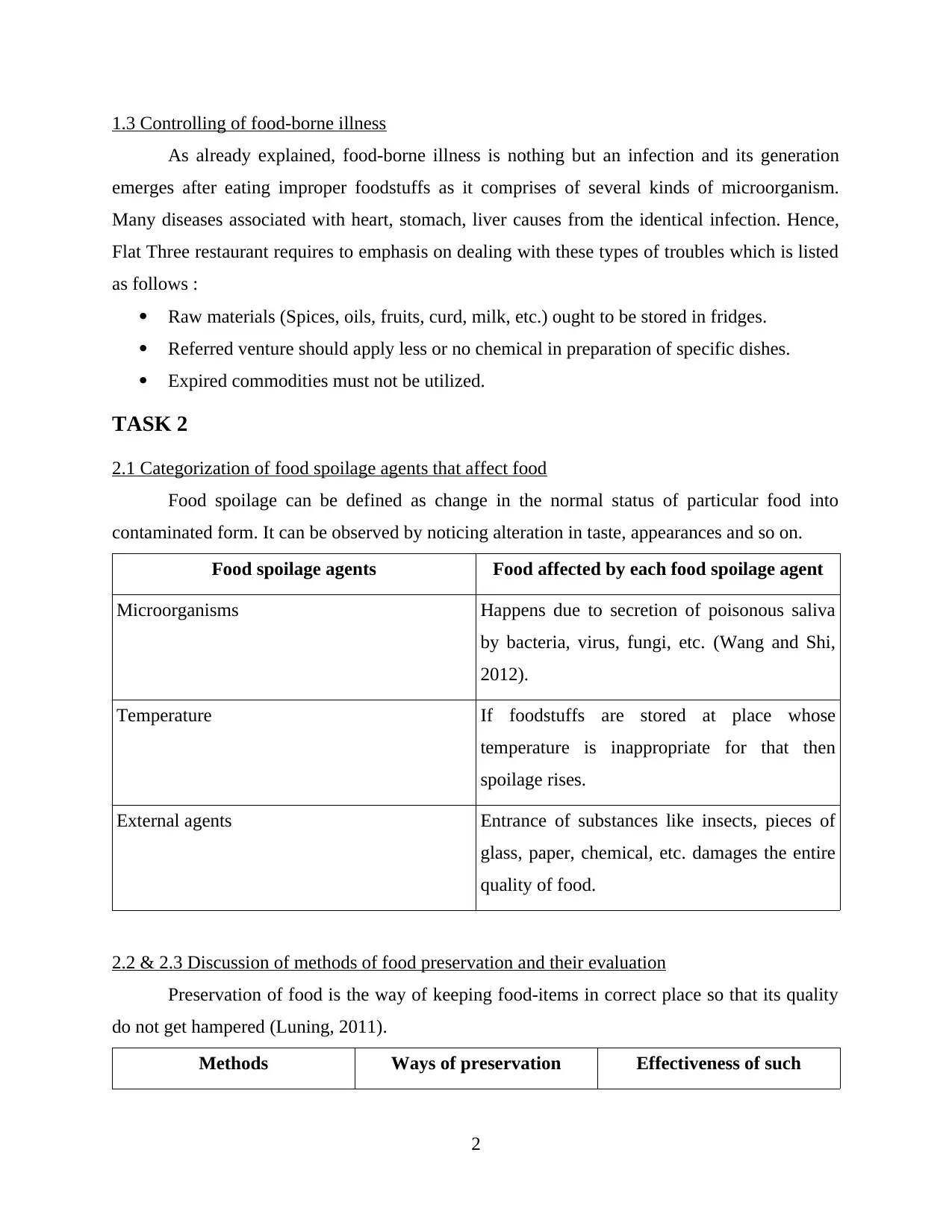
1.3 Controlling of food-borne illness
As already explained, food-borne illness is nothing but an infection and its generation
emerges after eating improper foodstuffs as it comprises of several kinds of microorganism.
Many diseases associated with heart, stomach, liver causes from the identical infection. Hence,
Flat Three restaurant requires to emphasis on dealing with these types of troubles which is listed
as follows :
Raw materials (Spices, oils, fruits, curd, milk, etc.) ought to be stored in fridges.
Referred venture should apply less or no chemical in preparation of specific dishes.
Expired commodities must not be utilized.
TASK 2
2.1 Categorization of food spoilage agents that affect food
Food spoilage can be defined as change in the normal status of particular food into
contaminated form. It can be observed by noticing alteration in taste, appearances and so on.
Food spoilage agents Food affected by each food spoilage agent
Microorganisms Happens due to secretion of poisonous saliva
by bacteria, virus, fungi, etc. (Wang and Shi,
2012).
Temperature If foodstuffs are stored at place whose
temperature is inappropriate for that then
spoilage rises.
External agents Entrance of substances like insects, pieces of
glass, paper, chemical, etc. damages the entire
quality of food.
2.2 & 2.3 Discussion of methods of food preservation and their evaluation
Preservation of food is the way of keeping food-items in correct place so that its quality
do not get hampered (Luning, 2011).
Methods Ways of preservation Effectiveness of such
2
As already explained, food-borne illness is nothing but an infection and its generation
emerges after eating improper foodstuffs as it comprises of several kinds of microorganism.
Many diseases associated with heart, stomach, liver causes from the identical infection. Hence,
Flat Three restaurant requires to emphasis on dealing with these types of troubles which is listed
as follows :
Raw materials (Spices, oils, fruits, curd, milk, etc.) ought to be stored in fridges.
Referred venture should apply less or no chemical in preparation of specific dishes.
Expired commodities must not be utilized.
TASK 2
2.1 Categorization of food spoilage agents that affect food
Food spoilage can be defined as change in the normal status of particular food into
contaminated form. It can be observed by noticing alteration in taste, appearances and so on.
Food spoilage agents Food affected by each food spoilage agent
Microorganisms Happens due to secretion of poisonous saliva
by bacteria, virus, fungi, etc. (Wang and Shi,
2012).
Temperature If foodstuffs are stored at place whose
temperature is inappropriate for that then
spoilage rises.
External agents Entrance of substances like insects, pieces of
glass, paper, chemical, etc. damages the entire
quality of food.
2.2 & 2.3 Discussion of methods of food preservation and their evaluation
Preservation of food is the way of keeping food-items in correct place so that its quality
do not get hampered (Luning, 2011).
Methods Ways of preservation Effectiveness of such
2
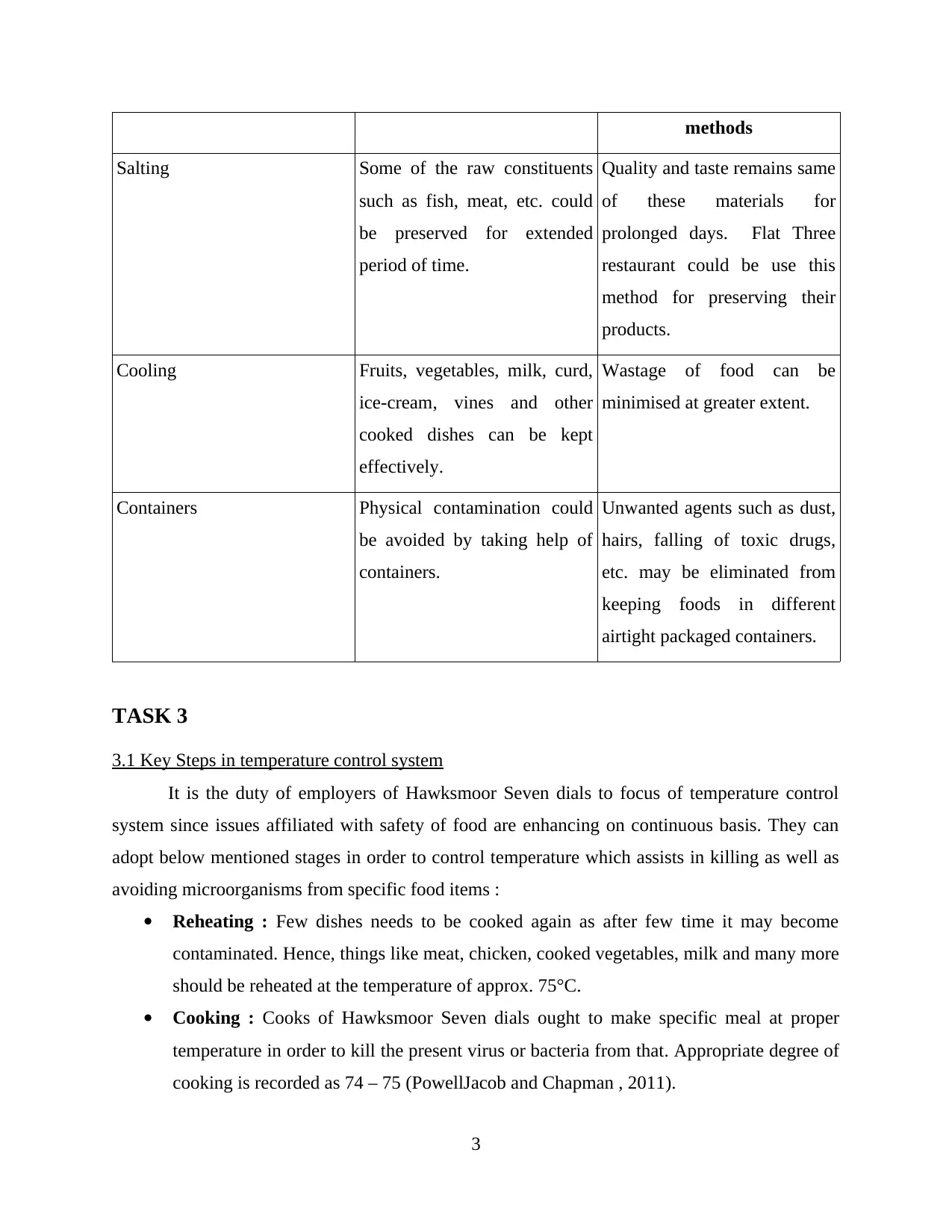
methods
Salting Some of the raw constituents
such as fish, meat, etc. could
be preserved for extended
period of time.
Quality and taste remains same
of these materials for
prolonged days. Flat Three
restaurant could be use this
method for preserving their
products.
Cooling Fruits, vegetables, milk, curd,
ice-cream, vines and other
cooked dishes can be kept
effectively.
Wastage of food can be
minimised at greater extent.
Containers Physical contamination could
be avoided by taking help of
containers.
Unwanted agents such as dust,
hairs, falling of toxic drugs,
etc. may be eliminated from
keeping foods in different
airtight packaged containers.
TASK 3
3.1 Key Steps in temperature control system
It is the duty of employers of Hawksmoor Seven dials to focus of temperature control
system since issues affiliated with safety of food are enhancing on continuous basis. They can
adopt below mentioned stages in order to control temperature which assists in killing as well as
avoiding microorganisms from specific food items :
Reheating : Few dishes needs to be cooked again as after few time it may become
contaminated. Hence, things like meat, chicken, cooked vegetables, milk and many more
should be reheated at the temperature of approx. 75°C.
Cooking : Cooks of Hawksmoor Seven dials ought to make specific meal at proper
temperature in order to kill the present virus or bacteria from that. Appropriate degree of
cooking is recorded as 74 – 75 (PowellJacob and Chapman , 2011).
3
Salting Some of the raw constituents
such as fish, meat, etc. could
be preserved for extended
period of time.
Quality and taste remains same
of these materials for
prolonged days. Flat Three
restaurant could be use this
method for preserving their
products.
Cooling Fruits, vegetables, milk, curd,
ice-cream, vines and other
cooked dishes can be kept
effectively.
Wastage of food can be
minimised at greater extent.
Containers Physical contamination could
be avoided by taking help of
containers.
Unwanted agents such as dust,
hairs, falling of toxic drugs,
etc. may be eliminated from
keeping foods in different
airtight packaged containers.
TASK 3
3.1 Key Steps in temperature control system
It is the duty of employers of Hawksmoor Seven dials to focus of temperature control
system since issues affiliated with safety of food are enhancing on continuous basis. They can
adopt below mentioned stages in order to control temperature which assists in killing as well as
avoiding microorganisms from specific food items :
Reheating : Few dishes needs to be cooked again as after few time it may become
contaminated. Hence, things like meat, chicken, cooked vegetables, milk and many more
should be reheated at the temperature of approx. 75°C.
Cooking : Cooks of Hawksmoor Seven dials ought to make specific meal at proper
temperature in order to kill the present virus or bacteria from that. Appropriate degree of
cooking is recorded as 74 – 75 (PowellJacob and Chapman , 2011).
3
⊘ This is a preview!⊘
Do you want full access?
Subscribe today to unlock all pages.

Trusted by 1+ million students worldwide
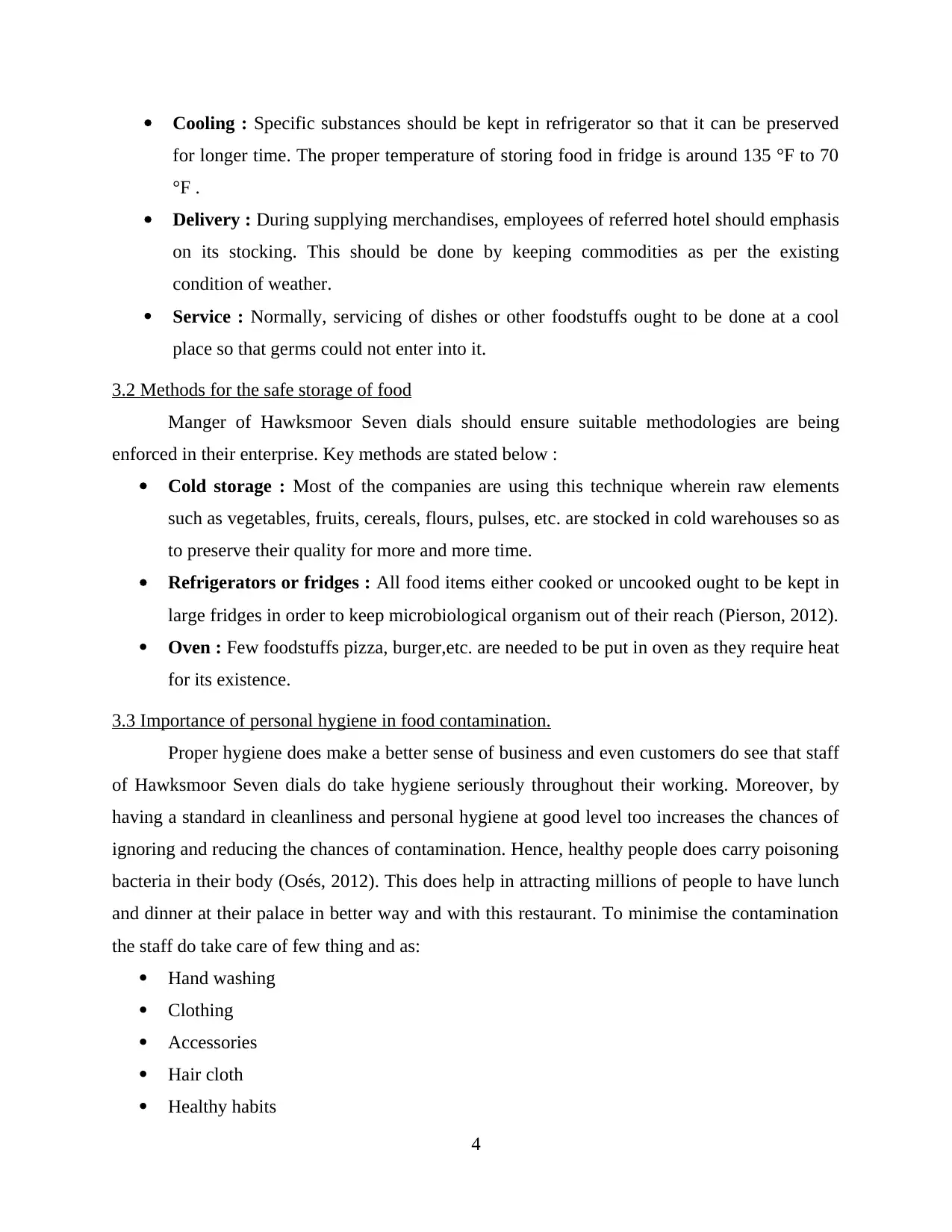
Cooling : Specific substances should be kept in refrigerator so that it can be preserved
for longer time. The proper temperature of storing food in fridge is around 135 °F to 70
°F .
Delivery : During supplying merchandises, employees of referred hotel should emphasis
on its stocking. This should be done by keeping commodities as per the existing
condition of weather.
Service : Normally, servicing of dishes or other foodstuffs ought to be done at a cool
place so that germs could not enter into it.
3.2 Methods for the safe storage of food
Manger of Hawksmoor Seven dials should ensure suitable methodologies are being
enforced in their enterprise. Key methods are stated below :
Cold storage : Most of the companies are using this technique wherein raw elements
such as vegetables, fruits, cereals, flours, pulses, etc. are stocked in cold warehouses so as
to preserve their quality for more and more time.
Refrigerators or fridges : All food items either cooked or uncooked ought to be kept in
large fridges in order to keep microbiological organism out of their reach (Pierson, 2012).
Oven : Few foodstuffs pizza, burger,etc. are needed to be put in oven as they require heat
for its existence.
3.3 Importance of personal hygiene in food contamination.
Proper hygiene does make a better sense of business and even customers do see that staff
of Hawksmoor Seven dials do take hygiene seriously throughout their working. Moreover, by
having a standard in cleanliness and personal hygiene at good level too increases the chances of
ignoring and reducing the chances of contamination. Hence, healthy people does carry poisoning
bacteria in their body (Osés, 2012). This does help in attracting millions of people to have lunch
and dinner at their palace in better way and with this restaurant. To minimise the contamination
the staff do take care of few thing and as:
Hand washing
Clothing
Accessories
Hair cloth
Healthy habits
4
for longer time. The proper temperature of storing food in fridge is around 135 °F to 70
°F .
Delivery : During supplying merchandises, employees of referred hotel should emphasis
on its stocking. This should be done by keeping commodities as per the existing
condition of weather.
Service : Normally, servicing of dishes or other foodstuffs ought to be done at a cool
place so that germs could not enter into it.
3.2 Methods for the safe storage of food
Manger of Hawksmoor Seven dials should ensure suitable methodologies are being
enforced in their enterprise. Key methods are stated below :
Cold storage : Most of the companies are using this technique wherein raw elements
such as vegetables, fruits, cereals, flours, pulses, etc. are stocked in cold warehouses so as
to preserve their quality for more and more time.
Refrigerators or fridges : All food items either cooked or uncooked ought to be kept in
large fridges in order to keep microbiological organism out of their reach (Pierson, 2012).
Oven : Few foodstuffs pizza, burger,etc. are needed to be put in oven as they require heat
for its existence.
3.3 Importance of personal hygiene in food contamination.
Proper hygiene does make a better sense of business and even customers do see that staff
of Hawksmoor Seven dials do take hygiene seriously throughout their working. Moreover, by
having a standard in cleanliness and personal hygiene at good level too increases the chances of
ignoring and reducing the chances of contamination. Hence, healthy people does carry poisoning
bacteria in their body (Osés, 2012). This does help in attracting millions of people to have lunch
and dinner at their palace in better way and with this restaurant. To minimise the contamination
the staff do take care of few thing and as:
Hand washing
Clothing
Accessories
Hair cloth
Healthy habits
4
Paraphrase This Document
Need a fresh take? Get an instant paraphrase of this document with our AI Paraphraser
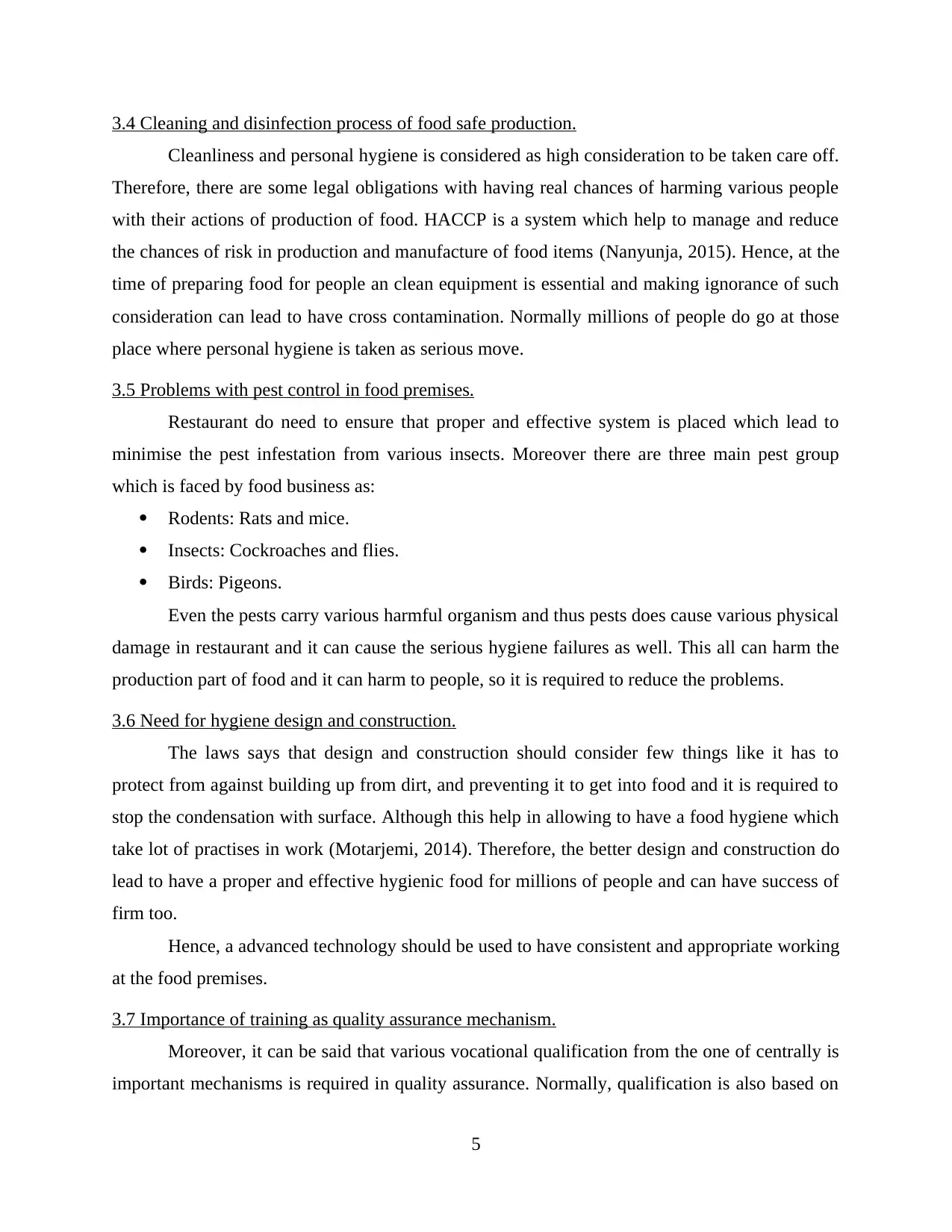
3.4 Cleaning and disinfection process of food safe production.
Cleanliness and personal hygiene is considered as high consideration to be taken care off.
Therefore, there are some legal obligations with having real chances of harming various people
with their actions of production of food. HACCP is a system which help to manage and reduce
the chances of risk in production and manufacture of food items (Nanyunja, 2015). Hence, at the
time of preparing food for people an clean equipment is essential and making ignorance of such
consideration can lead to have cross contamination. Normally millions of people do go at those
place where personal hygiene is taken as serious move.
3.5 Problems with pest control in food premises.
Restaurant do need to ensure that proper and effective system is placed which lead to
minimise the pest infestation from various insects. Moreover there are three main pest group
which is faced by food business as:
Rodents: Rats and mice.
Insects: Cockroaches and flies.
Birds: Pigeons.
Even the pests carry various harmful organism and thus pests does cause various physical
damage in restaurant and it can cause the serious hygiene failures as well. This all can harm the
production part of food and it can harm to people, so it is required to reduce the problems.
3.6 Need for hygiene design and construction.
The laws says that design and construction should consider few things like it has to
protect from against building up from dirt, and preventing it to get into food and it is required to
stop the condensation with surface. Although this help in allowing to have a food hygiene which
take lot of practises in work (Motarjemi, 2014). Therefore, the better design and construction do
lead to have a proper and effective hygienic food for millions of people and can have success of
firm too.
Hence, a advanced technology should be used to have consistent and appropriate working
at the food premises.
3.7 Importance of training as quality assurance mechanism.
Moreover, it can be said that various vocational qualification from the one of centrally is
important mechanisms is required in quality assurance. Normally, qualification is also based on
5
Cleanliness and personal hygiene is considered as high consideration to be taken care off.
Therefore, there are some legal obligations with having real chances of harming various people
with their actions of production of food. HACCP is a system which help to manage and reduce
the chances of risk in production and manufacture of food items (Nanyunja, 2015). Hence, at the
time of preparing food for people an clean equipment is essential and making ignorance of such
consideration can lead to have cross contamination. Normally millions of people do go at those
place where personal hygiene is taken as serious move.
3.5 Problems with pest control in food premises.
Restaurant do need to ensure that proper and effective system is placed which lead to
minimise the pest infestation from various insects. Moreover there are three main pest group
which is faced by food business as:
Rodents: Rats and mice.
Insects: Cockroaches and flies.
Birds: Pigeons.
Even the pests carry various harmful organism and thus pests does cause various physical
damage in restaurant and it can cause the serious hygiene failures as well. This all can harm the
production part of food and it can harm to people, so it is required to reduce the problems.
3.6 Need for hygiene design and construction.
The laws says that design and construction should consider few things like it has to
protect from against building up from dirt, and preventing it to get into food and it is required to
stop the condensation with surface. Although this help in allowing to have a food hygiene which
take lot of practises in work (Motarjemi, 2014). Therefore, the better design and construction do
lead to have a proper and effective hygienic food for millions of people and can have success of
firm too.
Hence, a advanced technology should be used to have consistent and appropriate working
at the food premises.
3.7 Importance of training as quality assurance mechanism.
Moreover, it can be said that various vocational qualification from the one of centrally is
important mechanisms is required in quality assurance. Normally, qualification is also based on
5
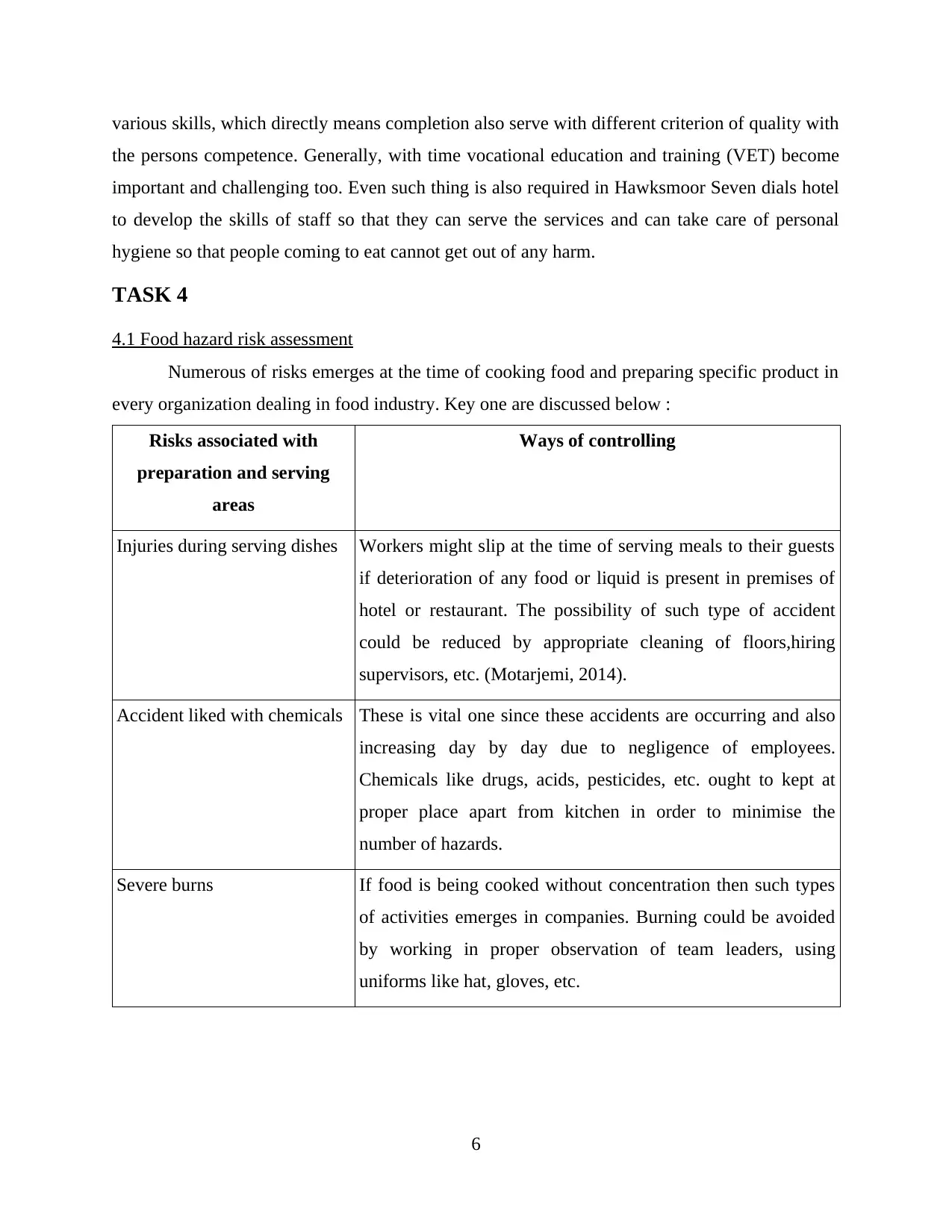
various skills, which directly means completion also serve with different criterion of quality with
the persons competence. Generally, with time vocational education and training (VET) become
important and challenging too. Even such thing is also required in Hawksmoor Seven dials hotel
to develop the skills of staff so that they can serve the services and can take care of personal
hygiene so that people coming to eat cannot get out of any harm.
TASK 4
4.1 Food hazard risk assessment
Numerous of risks emerges at the time of cooking food and preparing specific product in
every organization dealing in food industry. Key one are discussed below :
Risks associated with
preparation and serving
areas
Ways of controlling
Injuries during serving dishes Workers might slip at the time of serving meals to their guests
if deterioration of any food or liquid is present in premises of
hotel or restaurant. The possibility of such type of accident
could be reduced by appropriate cleaning of floors,hiring
supervisors, etc. (Motarjemi, 2014).
Accident liked with chemicals These is vital one since these accidents are occurring and also
increasing day by day due to negligence of employees.
Chemicals like drugs, acids, pesticides, etc. ought to kept at
proper place apart from kitchen in order to minimise the
number of hazards.
Severe burns If food is being cooked without concentration then such types
of activities emerges in companies. Burning could be avoided
by working in proper observation of team leaders, using
uniforms like hat, gloves, etc.
6
the persons competence. Generally, with time vocational education and training (VET) become
important and challenging too. Even such thing is also required in Hawksmoor Seven dials hotel
to develop the skills of staff so that they can serve the services and can take care of personal
hygiene so that people coming to eat cannot get out of any harm.
TASK 4
4.1 Food hazard risk assessment
Numerous of risks emerges at the time of cooking food and preparing specific product in
every organization dealing in food industry. Key one are discussed below :
Risks associated with
preparation and serving
areas
Ways of controlling
Injuries during serving dishes Workers might slip at the time of serving meals to their guests
if deterioration of any food or liquid is present in premises of
hotel or restaurant. The possibility of such type of accident
could be reduced by appropriate cleaning of floors,hiring
supervisors, etc. (Motarjemi, 2014).
Accident liked with chemicals These is vital one since these accidents are occurring and also
increasing day by day due to negligence of employees.
Chemicals like drugs, acids, pesticides, etc. ought to kept at
proper place apart from kitchen in order to minimise the
number of hazards.
Severe burns If food is being cooked without concentration then such types
of activities emerges in companies. Burning could be avoided
by working in proper observation of team leaders, using
uniforms like hat, gloves, etc.
6
⊘ This is a preview!⊘
Do you want full access?
Subscribe today to unlock all pages.

Trusted by 1+ million students worldwide
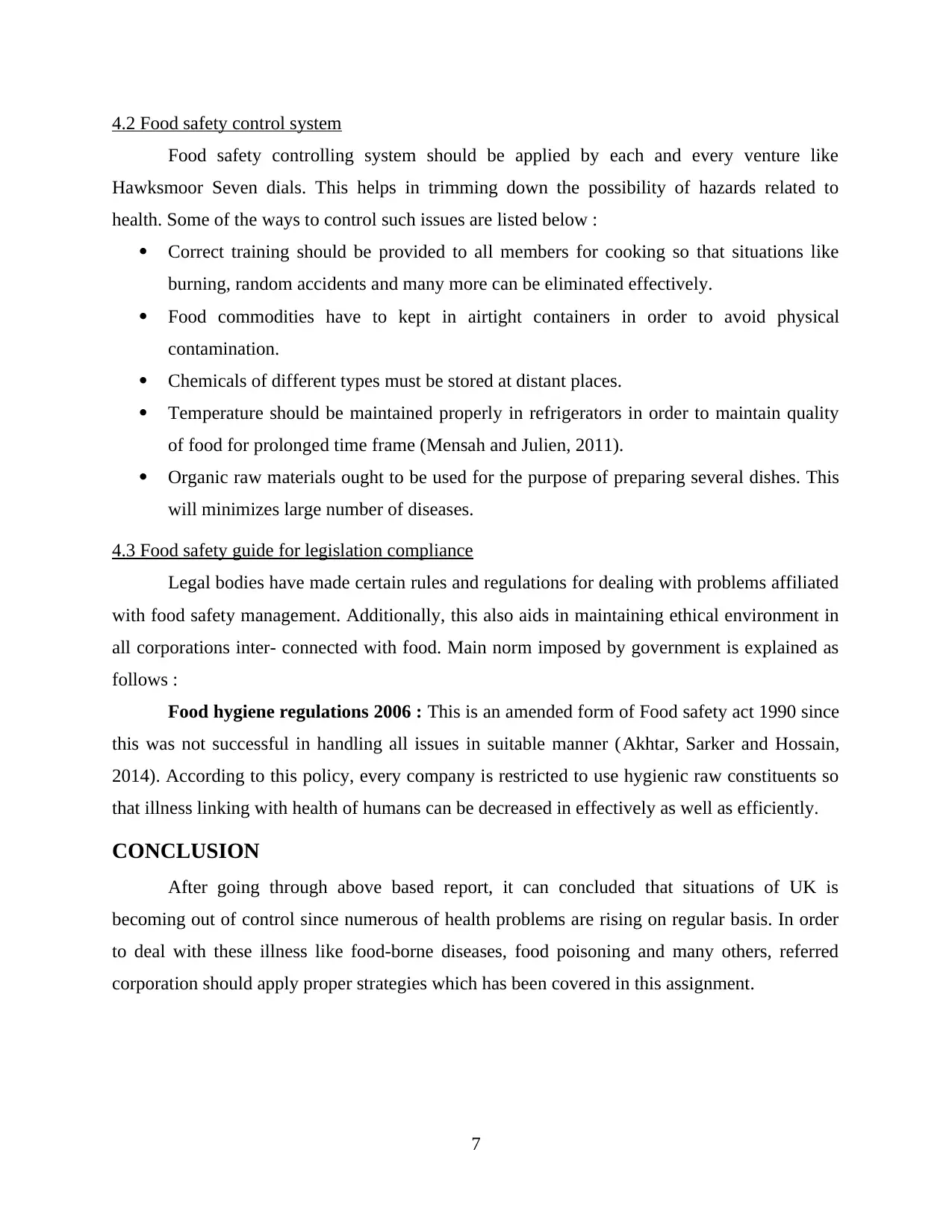
4.2 Food safety control system
Food safety controlling system should be applied by each and every venture like
Hawksmoor Seven dials. This helps in trimming down the possibility of hazards related to
health. Some of the ways to control such issues are listed below :
Correct training should be provided to all members for cooking so that situations like
burning, random accidents and many more can be eliminated effectively.
Food commodities have to kept in airtight containers in order to avoid physical
contamination.
Chemicals of different types must be stored at distant places.
Temperature should be maintained properly in refrigerators in order to maintain quality
of food for prolonged time frame (Mensah and Julien, 2011).
Organic raw materials ought to be used for the purpose of preparing several dishes. This
will minimizes large number of diseases.
4.3 Food safety guide for legislation compliance
Legal bodies have made certain rules and regulations for dealing with problems affiliated
with food safety management. Additionally, this also aids in maintaining ethical environment in
all corporations inter- connected with food. Main norm imposed by government is explained as
follows :
Food hygiene regulations 2006 : This is an amended form of Food safety act 1990 since
this was not successful in handling all issues in suitable manner (Akhtar, Sarker and Hossain,
2014). According to this policy, every company is restricted to use hygienic raw constituents so
that illness linking with health of humans can be decreased in effectively as well as efficiently.
CONCLUSION
After going through above based report, it can concluded that situations of UK is
becoming out of control since numerous of health problems are rising on regular basis. In order
to deal with these illness like food-borne diseases, food poisoning and many others, referred
corporation should apply proper strategies which has been covered in this assignment.
7
Food safety controlling system should be applied by each and every venture like
Hawksmoor Seven dials. This helps in trimming down the possibility of hazards related to
health. Some of the ways to control such issues are listed below :
Correct training should be provided to all members for cooking so that situations like
burning, random accidents and many more can be eliminated effectively.
Food commodities have to kept in airtight containers in order to avoid physical
contamination.
Chemicals of different types must be stored at distant places.
Temperature should be maintained properly in refrigerators in order to maintain quality
of food for prolonged time frame (Mensah and Julien, 2011).
Organic raw materials ought to be used for the purpose of preparing several dishes. This
will minimizes large number of diseases.
4.3 Food safety guide for legislation compliance
Legal bodies have made certain rules and regulations for dealing with problems affiliated
with food safety management. Additionally, this also aids in maintaining ethical environment in
all corporations inter- connected with food. Main norm imposed by government is explained as
follows :
Food hygiene regulations 2006 : This is an amended form of Food safety act 1990 since
this was not successful in handling all issues in suitable manner (Akhtar, Sarker and Hossain,
2014). According to this policy, every company is restricted to use hygienic raw constituents so
that illness linking with health of humans can be decreased in effectively as well as efficiently.
CONCLUSION
After going through above based report, it can concluded that situations of UK is
becoming out of control since numerous of health problems are rising on regular basis. In order
to deal with these illness like food-borne diseases, food poisoning and many others, referred
corporation should apply proper strategies which has been covered in this assignment.
7
Paraphrase This Document
Need a fresh take? Get an instant paraphrase of this document with our AI Paraphraser
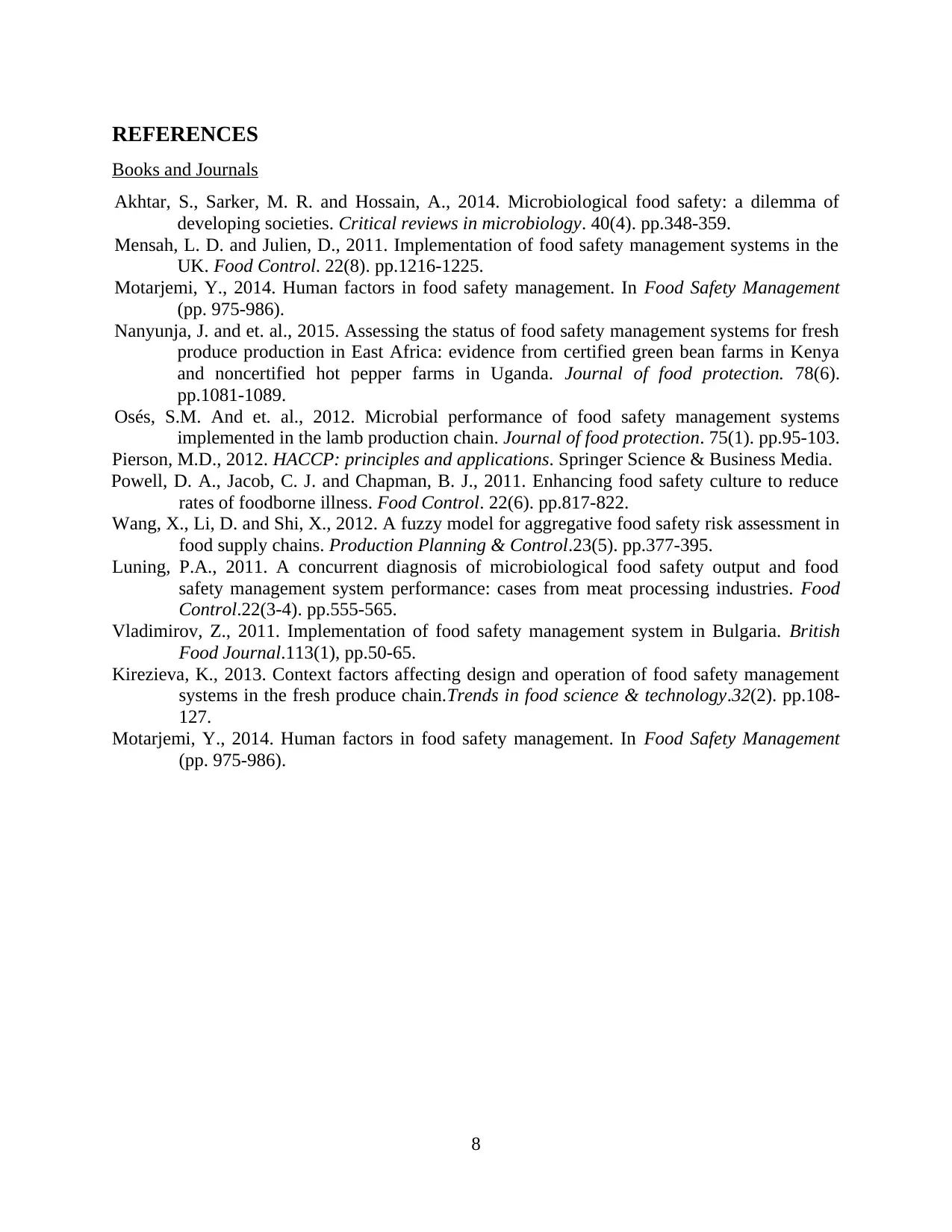
REFERENCES
Books and Journals
Akhtar, S., Sarker, M. R. and Hossain, A., 2014. Microbiological food safety: a dilemma of
developing societies. Critical reviews in microbiology. 40(4). pp.348-359.
Mensah, L. D. and Julien, D., 2011. Implementation of food safety management systems in the
UK. Food Control. 22(8). pp.1216-1225.
Motarjemi, Y., 2014. Human factors in food safety management. In Food Safety Management
(pp. 975-986).
Nanyunja, J. and et. al., 2015. Assessing the status of food safety management systems for fresh
produce production in East Africa: evidence from certified green bean farms in Kenya
and noncertified hot pepper farms in Uganda. Journal of food protection. 78(6).
pp.1081-1089.
Osés, S.M. And et. al., 2012. Microbial performance of food safety management systems
implemented in the lamb production chain. Journal of food protection. 75(1). pp.95-103.
Pierson, M.D., 2012. HACCP: principles and applications. Springer Science & Business Media.
Powell, D. A., Jacob, C. J. and Chapman, B. J., 2011. Enhancing food safety culture to reduce
rates of foodborne illness. Food Control. 22(6). pp.817-822.
Wang, X., Li, D. and Shi, X., 2012. A fuzzy model for aggregative food safety risk assessment in
food supply chains. Production Planning & Control.23(5). pp.377-395.
Luning, P.A., 2011. A concurrent diagnosis of microbiological food safety output and food
safety management system performance: cases from meat processing industries. Food
Control.22(3-4). pp.555-565.
Vladimirov, Z., 2011. Implementation of food safety management system in Bulgaria. British
Food Journal.113(1), pp.50-65.
Kirezieva, K., 2013. Context factors affecting design and operation of food safety management
systems in the fresh produce chain.Trends in food science & technology.32(2). pp.108-
127.
Motarjemi, Y., 2014. Human factors in food safety management. In Food Safety Management
(pp. 975-986).
8
Books and Journals
Akhtar, S., Sarker, M. R. and Hossain, A., 2014. Microbiological food safety: a dilemma of
developing societies. Critical reviews in microbiology. 40(4). pp.348-359.
Mensah, L. D. and Julien, D., 2011. Implementation of food safety management systems in the
UK. Food Control. 22(8). pp.1216-1225.
Motarjemi, Y., 2014. Human factors in food safety management. In Food Safety Management
(pp. 975-986).
Nanyunja, J. and et. al., 2015. Assessing the status of food safety management systems for fresh
produce production in East Africa: evidence from certified green bean farms in Kenya
and noncertified hot pepper farms in Uganda. Journal of food protection. 78(6).
pp.1081-1089.
Osés, S.M. And et. al., 2012. Microbial performance of food safety management systems
implemented in the lamb production chain. Journal of food protection. 75(1). pp.95-103.
Pierson, M.D., 2012. HACCP: principles and applications. Springer Science & Business Media.
Powell, D. A., Jacob, C. J. and Chapman, B. J., 2011. Enhancing food safety culture to reduce
rates of foodborne illness. Food Control. 22(6). pp.817-822.
Wang, X., Li, D. and Shi, X., 2012. A fuzzy model for aggregative food safety risk assessment in
food supply chains. Production Planning & Control.23(5). pp.377-395.
Luning, P.A., 2011. A concurrent diagnosis of microbiological food safety output and food
safety management system performance: cases from meat processing industries. Food
Control.22(3-4). pp.555-565.
Vladimirov, Z., 2011. Implementation of food safety management system in Bulgaria. British
Food Journal.113(1), pp.50-65.
Kirezieva, K., 2013. Context factors affecting design and operation of food safety management
systems in the fresh produce chain.Trends in food science & technology.32(2). pp.108-
127.
Motarjemi, Y., 2014. Human factors in food safety management. In Food Safety Management
(pp. 975-986).
8
1 out of 11
Related Documents
Your All-in-One AI-Powered Toolkit for Academic Success.
+13062052269
info@desklib.com
Available 24*7 on WhatsApp / Email
![[object Object]](/_next/static/media/star-bottom.7253800d.svg)
Unlock your academic potential
Copyright © 2020–2025 A2Z Services. All Rights Reserved. Developed and managed by ZUCOL.





